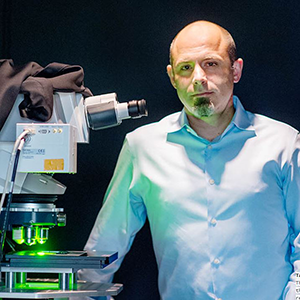Children's National Hospital welcomes Tarik F. Haydar, Ph.D., as incoming Director of the Center for Neuroscience Research
Haydar thinks of translational research as a two-way flow of expertise from the bench to the bedside

WASHINGTON –Tarik F. Haydar, Ph.D., an award-winning neurobiologist whose research teases out how brain development differs in people with typical cognitive function compared with people with developmental disabilities, like Down syndrome, has been named incoming Director of the Center for Neuroscience Research at Children’s National Hospital. Haydar, a professor in the department of Anatomy and Neurobiology at Boston University School of Medicine, will join Children’s National on Sept. 1, 2020.
As Director of the Center for Neuroscience Research, Haydar will oversee teams whose bench research informs clinical efforts to prevent or treat neurological, developmental and behavioral disorders that manifest during childhood but often have their origin within the womb.
“I am thrilled that our nationwide search identified Dr. Haydar as the premier candidate for this important position,” says Vittorio Gallo, Ph.D., Chief Research Officer at Children’s National. “We were impressed with his vision for our future and inspired by his enthusiasm in fulfilling the promise of additional research collaborations as we open and build out the Children’s National Research & Innovation Campus,” Gallo adds.
“I’m really excited. It almost feels like fate,” Haydar says. “Children’s National is where I established my first lab as a new assistant professor way back in 2002. It’s like coming home. One of the things I have been remembering and recommitting myself to is what translational research really means and the opportunity that a place like the Children’s National Research Institute (CNRI) enables: Being responsive to the clinical needs of patients and leveraging the power of CNRI and the Center for Neuroscience Research to investigate the underlying causes of neurodevelopmental disorders and working towards potential solutions,” he says.
On either side of that translational work, Haydar thinks of “superheroes” working together on vexing questions, such as how Zika viral infection leads to an arrest in brain development – best understood in the lab. And, once the mechanics are understood at a micro level, collaborating on innovative therapies and treatments to be used in the clinic.
“We hear a lot about ‘bench to bedside,’ which means basic research in the lab eventually making its way into the clinic and being applied as medicine for people,” he adds. “But it is also crucial to support that flow in the other direction, to start with needs or observations in the clinic and then engage basic research to provide insights that inform an improved standard of patient care.”
The timing of Haydar’s appointment enables him to be intimately involved with the opening of the hospital’s new regional innovation hub. Children’s National Research & Innovation Campus is the first of its kind dedicated to pediatric health care innovation. It is scheduled to open in December 2020 and will be anchored by the Center for Genetic Medicine Research and the Rare Disease Institute on a nearly 12-acre portion of the former Walter Reed Army Medical Center campus.
In addition to its strategic mid-Atlantic location, the new campus is physically close to federal research partners, especially the National Institutes of Health, with whom Children’s National has fruitful research collaborations.
“I am looking forward to being in that environment with our academic affiliate, the George Washington University, as well as the University of Maryland and now, Virginia Tech, as research partners,” he says. “Having the new campus as the epicenter for these public-private research collaborations opens the potential to improve medicine for the benefit of not only Children’s National patients but for all kids.”
Media contact: Diedtra Henderson | 443-610-9826 | 202-476-4500



